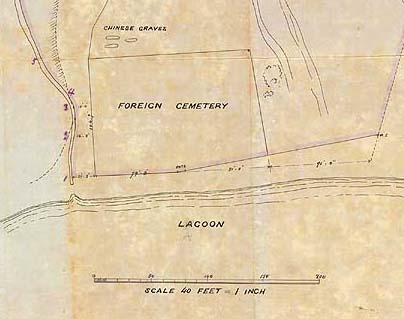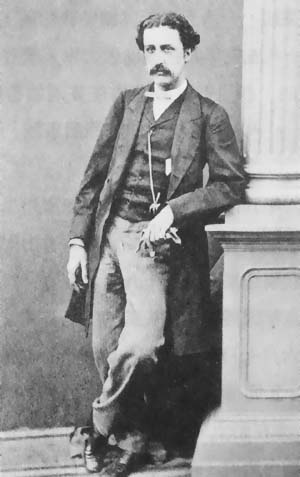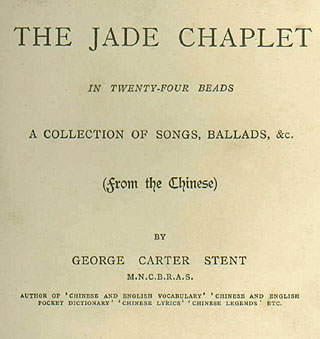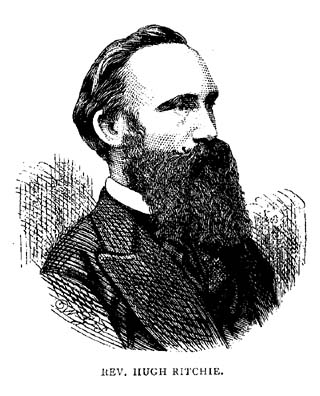|
|||||||||||||||||||||||||||||||||||||||||||||||||||||||||||||||||||||||||||||||||||||||||||||||||||||||||||
|
The Graveyard Files |
|||||||||||||||||||||||||||||||||||||||||||||||||||||||||||||||||||||||||||||||||||||||||||||||||||||||||||
| Introduction
During the latter years of the 19th century a Foreign Cemetery was established in Kaohsiung, then known as Takow. The plan on the right, from the British Foreign Offices files, was drawn in 1905. Today, almost all trace of the graveyard has gone and very few of the once more than thirty gravestones can be found by even the most diligent searcher willing to risk local taboos. However, those men, women and children who were buried in the cemetery after ending their days in Takow have some interesting tales to tell. |
[British Crown Copyright] |
||||||||||||||||||||||||||||||||||||||||||||||||||||||||||||||||||||||||||||||||||||||||||||||||||||||||||
| The Beginning | |||||||||||||||||||||||||||||||||||||||||||||||||||||||||||||||||||||||||||||||||||||||||||||||||||||||||||
|
|
As
with many tales about Takow, the story begins with Robert Swinhoe, the
eminent Victorian naturalist and British consular official.
In 1864, desiring to construct a house at Takow, Swinhoe had used his own money to purchase a site at ShaoChuanTou. Swinhoe enclosed part of the site with a wall and set a watchman inside in preparation for the construction of a consulate that could also serve as a suitable home for himself and his young wife Christina. Yet official permission for the construction was never to come, and Swinhoe was forced to rent a house on the other side of the Takow Lagoon to house the pregnant Christina. Swinhoe ceased to live in Takow in 1866, although he remained Taiwan's British Consul until 1873. The British consulate was housed in rented buildings at Takow until it was moved up to Tainan in 1872. Indeed the British were not to build a consulate at Takow until 1879. The site purchased by Swinhoe in 1864 thus lay vacant and unneeded for any consular construction. Accordingly Consul William Gregory sought permission in 1871 to enclose a small area as a Foreign Cemetery and to build a chapel thereon. Thus was the Foreign Cemetery born. However Swinhoe, who died in 1877, was never reimbursed for the cost of either the site or the graveyard. |
||||||||||||||||||||||||||||||||||||||||||||||||||||||||||||||||||||||||||||||||||||||||||||||||||||||||||
| Foreign
Cemetery
The Foreign Cemetery was thus established by public subscription in 1871. |
|||||||||||||||||||||||||||||||||||||||||||||||||||||||||||||||||||||||||||||||||||||||||||||||||||||||||||
|
|
|||||||||||||||||||||||||||||||||||||||||||||||||||||||||||||||||||||||||||||||||||||||||||||||||||||||||||
|
"The Takao foreign cemetery." The Messenger and Missionary Record of the Presbyterian Church of England n.s. 4 (1 November 1879): 209. (Courtesy John Shufelt) |
|||||||||||||||||||||||||||||||||||||||||||||||||||||||||||||||||||||||||||||||||||||||||||||||||||||||||||
|
Graveyard List (Information from
Presbyterian Church records, Davidson, Otness and Myers)
|
|||||||||||||||||||||||||||||||||||||||||||||||||||||||||||||||||||||||||||||||||||||||||||||||||||||||||||
|
|
|||||||||||||||||||||||||||||||||||||||||||||||||||||||||||||||||||||||||||||||||||||||||||||||||||||||||||
| Graveyard Tales | |||||||||||||||||||||||||||||||||||||||||||||||||||||||||||||||||||||||||||||||||||||||||||||||||||||||||||
| George
Carter Stent (1833
-
1884)
George Carter Stent, who was buried in the Takow Foreign Cemetery in 1884, was the Assistant-in-Charge at the Imperial Chinese Maritime Customs (CMC) in Takow at the time of his death. His life was both adventuresome and literary. From his own writings we can learn that he was a private in the 14th (King's Light) Dragoons during the Indian Mutiny, and for his service he received the Indian Mutiny Medal. His memoirs of the King's Light, entitled “Scraps from my sabretasche: Being personal adventures while in the 14th (King's Light) Dragoons”, were published in 1882 by W H Allen & Co. (London). Stent was also an early Western authority on palace eunuchs in Ching [see G. C. Stent, Chinese Eunuchs, in Journal of the Royal Society, North China Branch. no, XI, 1887]. Although his study of palace eunuchs was made late in imperial Ching rule, the eunuchs' clinic which he described is known to have existed in the preceding Ming Dynasty, and it is assumed that many of its methods were in use long before the Ming era. In Stent's time there were only around 2,000 eunuchs employed in the Forbidden City, for the Manchu emperors had been determined to keep their numbers down. Another reason for the greatly reduced number of eunuchs may have been that during the previous fifty years, the Manchu Dynasty was ruled by a regent, Empress Dowager Tzu Hsi, for two successive little boy emperors, which would have considerably lessened the need for concubines. |
|||||||||||||||||||||||||||||||||||||||||||||||||||||||||||||||||||||||||||||||||||||||||||||||||||||||||||
|
|
W H Allen & Co also published The Jade Chaplet, in Twenty-four Beads. A Collection of Songs, Ballads, etc., from the Chinese, by Stent in 1874. This book contains translations of some of the old Chinese ballads on the subject of the Emperor Ming Huang of the T`ang dynasty, although his verse is considered as poor in quality. Stent also published several dictionaries, including A Chinese and English Pocket Dictionary (Shanghai: Kelly and Co.; Hong Kong: Lane, Crawford & Co., 1874), A Chinese and English Vocabulary in the Pekinese Dialect (Shanghai: American Presbyterian Mission Press, 1877), and A Dictionary from English to Colloquial Mandarin Chinese (Shanghai: Statistical Department of the Inspectorate General of Customs, 1905). As Assistant-in-Charge at Takow, Stent prepared the Takow Trade Report for the year 1883 which touches on the vagaries of the opium market as well as expressing concern over the possible complicity of compradores in the collapse of two foreign firms, including Elles & Co. |
||||||||||||||||||||||||||||||||||||||||||||||||||||||||||||||||||||||||||||||||||||||||||||||||||||||||||
|
A much fuller account of George Carter Stent's life can now be found in the Personnel Files. (click here) |
|||||||||||||||||||||||||||||||||||||||||||||||||||||||||||||||||||||||||||||||||||||||||||||||||||||||||||
|
|
|||||||||||||||||||||||||||||||||||||||||||||||||||||||||||||||||||||||||||||||||||||||||||||||||||||||||||
| Mary
Donnithorne
Warren
The unfortunate Mary Warren was the wife of the British Acting-Consul Pelham Warren. The couple were probably the first to live at the British Consular Residence that had been built on the hill at ShaoChuanTou in 1879, and she certainly the first death. Once again, Dr W W Myers records the strange details of Mrs Warren's tragic death, which he attributes to 'direct and concentrated drain-poisoning', in his 1884 Medical Report for Takow. Myers relates that, while 'for some time prior to death the patient had been complaining of obscure symptoms, general languor, loss of flesh, rising unrefreshed in the morning, with occasional attacks of diarrhoea and fever, (the) most careful and frequent examinations failed to detect any organic derangement'. |
|||||||||||||||||||||||||||||||||||||||||||||||||||||||||||||||||||||||||||||||||||||||||||||||||||||||||||
|
He added that the 'very position of the house, on the
summit of a hill, removed from all other habitations, coupled with the
apparent absence of any reason for ... a sewer', led to the discounting
of foul air as a problem.
However, a 'day or two before (her death) a peculiar odour was detected on coming up the hill, and this, after careful tracing to its source, was found to emanate from a split tile which some animal in running across had broken, and here the foulest gas was literally hissing up. Excavations were at once commenced, and a choked drain was discovered leading to the kitchen door, and filled with a mass of the foulest putrefying matter. Both the foreigners, who stood in the open air, superintending the cleansing and laying open of the sewer were seized with severe headache, and one suffered in addition from vomiting and purging'. |
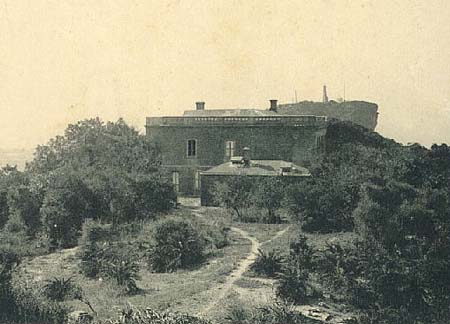
The British Consular Residence in 1910 |
||||||||||||||||||||||||||||||||||||||||||||||||||||||||||||||||||||||||||||||||||||||||||||||||||||||||||
|
Myers explains 'that the kitchen and other out-offices formed one side of a quadrangular court surrounded by high walls, and opposite to them was the back of the dwelling-house, with a door which acted as a strong up-take for the air circulating chiefly on the bed-room side of the house. The rush of air through this door was very strong, and thus all the foul emanations from the upper opening of the drain were directly driven up and along the sleeping apartments. This drain was undoubtedly intended originally to convey rain water only from the courtyard, for discharge over the adjacent side of the hill; but situated as it was, in close proximity to the kitchen, of course it formed a most tempting receptacle for culinary and household slops.' It is possible that the building was not lived in for a period thereafter. A strongbox, containing many Land Deeds, was reportedly stolen from the building some months later, and after 1885 a new Consulate was built at Anping. |
|||||||||||||||||||||||||||||||||||||||||||||||||||||||||||||||||||||||||||||||||||||||||||||||||||||||||||
|
|
|||||||||||||||||||||||||||||||||||||||||||||||||||||||||||||||||||||||||||||||||||||||||||||||||||||||||||
| Reverend Hugh Ritchie (c.1840 - 29 September 1879) | |||||||||||||||||||||||||||||||||||||||||||||||||||||||||||||||||||||||||||||||||||||||||||||||||||||||||||
|
(from Campbell's 'Missionary Success in the Island of Formosa') |
The Reverend Hugh Ritchie was sent by the English Presbyterian church to
Formosa as a missionary in 1867. The post was vacant as the previous
missionary, David Masson, had been swept overboard and drowned off the
coast of China before even reaching Taiwan. Ritchie began his missionary work on 13 December 1867 when he joined Dr James Maxwell of the English Protestant mission at Takow. At the beginning, their proselytising met with strong resistance, culminating in the burning of a church in May 1868.
However, Ritchie learnt both Hokkien and Hakka, and succeeded in
founding ten churches in the Takow area. Rev George Mackay, who arrived
at Takow in December 1871, stayed with Ritchie for three months before
leaving to establish a new Presbyterian mission in the north at Tamsui.
In 1875, Ritchie became the first missionary to visit the east coast. Ritchie's account of his journey to the east coast was published as "Notes of a Journey in East Formosa" in The Chinese Recorder and Missionary Journal 6 (1875) on pages 206-211. |
||||||||||||||||||||||||||||||||||||||||||||||||||||||||||||||||||||||||||||||||||||||||||||||||||||||||||
|
Ritchie came to Taiwan with his wife, and together they raised several
children, including a son, Robert Ritchie, who died at the age of three
in 1873 and was buried in the Takow cemetery. Ritchie died of fever on
29 September 1879 at the age of 39 and was buried beside his son in the
Takow graveyard.
Ritchie’s wife continued their work of promoting the education of women, and was instrumental in the founding of the Tainan Presbyterian Girls’ School in 1887. The picture on the right shows the first graduating class. Although rebuilt in 1923, the school continues today as the Chang Jung Girls High School. |
|
||||||||||||||||||||||||||||||||||||||||||||||||||||||||||||||||||||||||||||||||||||||||||||||||||||||||||
|
|||||||||||||||||||||||||||||||||||||||||||||||||||||||||||||||||||||||||||||||||||||||||||||||||||||||||||
